Creative Change and Innovation Assignment
Introduction
Consumer demand tends to create a high impact on the product range and change management aspects within an organisation. It also seems to be impacting the aspects of innovation for enhancing production levels. The current report will be highlighting consumer demand trends within the UK and their impact on Unilever along with the change management aspects within the organisation.
Overview of the company
Unilever Plc is a consumer goods company headquartered in the UK and operating since 1929 (Unilever, 2022). The company includes various products such as foods, beauty products, ice cream, household products, baby care products, hygiene products, product care, and many others. The company seems to be operating in more than 190 countries and is having a high presence within national and international markets (Unilever, 2022). In the current scenario, the revenue of the company depicts £52444 million in 2021 that further is analysed to be higher than the previous year depicting £50724 in 2020 (Sabanoglu, 2022). Though the amount seems to be fluctuating as per the figure below, overall the company is observed to be having successful operations.
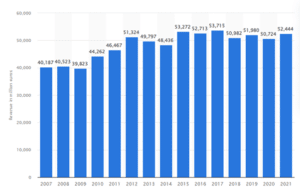
Figure 1: Revenue of Unilever
(Source: Sabanoglu, 2022)
Analysis
Analysis of the consumer demand
Effect of changing consumer demand on the creativity or product range of Unilever
The markets of goods alongside services have been observed to be undergoing a profound transformation in the past years. It includes changes within regulatory reform along with new technology growth in terms of services, global markets and many others. According to Parrish et al. (2020), consumers within the market have also changed their lifestyles, which further changed their demand for the products and services available in the market. Expansion in terms of goods and service choices that are available to the end users is one of the most significant and distinctive changes in the past years (OECD, 2022). Concerning this, Unilever has also been observed to be adding variety to the products and services offered to the customers and putting an effort to satisfy them. Other than that, advancements in information and technology are another most important change in consumer demand in the market (OECD, 2022). Most importantly, consumers within the market are observed to be spending more on innovative products and thus Unilever is also focused on implementing innovative notions within its products and services.
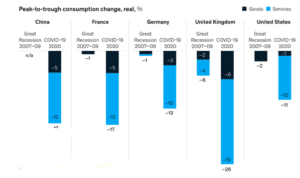
Figure 2: Changes in consumer consumption
(Source: Mckinsey, 2021)
Concerning this, the company seems to be investing in partnerships along with specialists, suppliers, academic institutions and others to support the product’s needs as per consumer demand (Unilever, 2022). Besides, covid also seems to be affecting consumer demand and bringing several changes within. The figure above depicts a high decline in consumer consumption in the domain of the UK indicating a 6% and 19% decline in the demand for goods and services respectively (Mckinsey, 2021). Meanwhile, the prevalence of covid in the past year has increased the demand for hygiene products to 45% in February 2021, which is higher than the previous year reflecting 29% in March 2020 (Statista, 2022) [Refer to Appendix 1]. The value of hygiene products is expected to reach £3832.3 million by the end of 2030 (Global Newswire, 2022). This also depicts a high increase in the production of health and hygiene products within Unilever to meet the increasing demand of consumers (Unilever, 2022). Henceforth, it can be stated that changes in consumer demand within the UK in the past years have led the company to adjust its production and manufacturing of products accordingly and have also helped the company to sustain itself within the market even at the time of the pandemic.
Impact of change drivers on the product range of Unilever
Drivers of change play a crucial part in managing the overall operations of an organisation. As per the STEEP model of change, common drivers related to change involve social, technology, economic, environmental and political factors (Akinyele et al. 2018). However, the stated drivers are aligned with the manufacturing and production aspects of an organisation and thus are responsible for bringing several changes within an organisational domain. As of Unilever, consistency is maintained within challenging environmental conditions. Despite the slower growth in the global scenario and the high rate of inflation, the company continues to implement innovation and variety within its products and services (Unilever, 2022). However, the turnover of the company grew by 9.4%, which further indicated a negative impact of economic drivers on the product range of the company (Unilever, 2022).
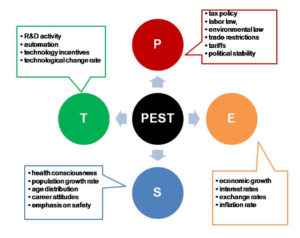
Figure 3: STEEP model of change
(Source: Akinyele et al. 2018)
On the other hand, political issues with the European Union have impacted the importing and exporting instances of Unilever and this created a high effect on its product range (Unilever, 2022). Socially, people have been highly conscious of their health and hygienic conditions. Concerning this, Unilever has been forced to introduce a variety of health and hygiene products of the company to meet consumer trends within the market (Unilever, 2022). In addition to this, consumers have also observed drip to be technologically advanced and it also has impacted the operating instances of Unilever. For instance, Unilever has used automated technology to implement innovative products and meet the technical needs of customers within the market (Unilever, 2022). Henceforth, several drivers of change have impacted the product range of Unilever adversely.
Effect of change on the strategic plans of Unilever
The changing consumer trains within the market seem to be having a high impact on the strategic plans of Unilever. Due to the high demand for technology within the market, Unilever has invested a high amount, which is £800 million in research and development (R&D) to enhance the products and services quality. Concerning this Unilever has created six R&D centres in different countries such as the US, Italy, China, Netherland, UK and India (Unilever, 2022). World-class technology is used by the company to enhance its product and service quality and bring excellence that can support the changing needs of customers within the market. However, Unilever also follows a proper strategy of innovation based on the theory of incremental innovation. According to Rubin and Abramson (2018), incremental innovation mainly denotes the production of goods and services based on consumer demands and trends within the market. This theory depicts that a company should implement the changing demands of customers immediately and should always follow the market train to satisfy the customer [Refer to Appendix 2]. Concerning this universe, we have been working to adapt to the changing situation and meet the changing needs of consumers and thus it shapes the strategic motion of the organisation.
Analysis of technological advancements and change management
Effect of technology on Unilever’s change management
Technology seems to be the heart of Unilever’s operation and maintains its innovative nature within the market. The company has been focused on the development of automated technology within its innovation centres and delivers targeted goals faster than traditional methods (Unilever, 2022). Besides, the company also seems to be running virtual tests alongside different scenarios to optimise different products before the stage of lab testing. In a single year, Unilever seems to be performing 12000 tests of rapid products that develop high efficiency of the company within the market (Unilever, 2022). It also helps the company to manage its change as per the changing requirements of the customers within the market. The reports of the company also stated that Unilever aims the development of new technology to tackle different issues within the global scenario (Unilever, 2020). For instance, the issue of the plastic consists of high importance in the national and international markets and this result in the development of groundbreaking technology by Unilever for recycling sachets (Unilever, 2020).
Sachets mainly ensure turning into plastic and channelling back into the supply chain and mitigating the issue of plastic use from the environment. In addition to this Unilever is also observed to be scaling and scoping up the technological advancement for smallholder farmers alongside micro retailers for improving their livelihoods (Unilever, 2020). This technology innovation of Unilever helps the customers to adapt technological instances within their operation and satisfy the trends within the market. Other than that, Unilever also uses virtual factories to maintain its supply chain (Smith, 2022). Due to changing demands of customers, Unilever needs to follow the changing trends and implement necessary concepts to adjust its products and services as per customer requirements. As per Helo and Hao (2021), proper management of the supply chain assists in the management of resources and helps to comply with the needs of the customers. As a result, the implementation of virtual factories helps Unilever to analyse and change necessary aspects to meet the changing consumer demand. It also assists the company to manage change within the organisational domain and thus helps in its sustainable operations.
Impact of environmental issues on the change management of the company
Several factors within an environment define different issues related to the environment faced by an organisation. In consideration of this, PESTLE analysis evaluates six such factors that define different impacts of macro environment instances on organisational operations. These factors include political factors, economic factors, social factors, technological factors, legal factors, and environmental factors (Christodoulou and Cullinane, 2019). In the case of Unilever, different macro-environmental factors about PESTLE seem to be impacting the operating notion of the company [Refer to Appendix 3]. From the PESTLE analysis of the UK, Unilever seems to be having a stable political condition within the UK domain that further has been maintaining a proper market position within the nation. However Brexit prevalence has affected the operations of Unilever as it restricts import and export instances of the company (Overseas, 2021).
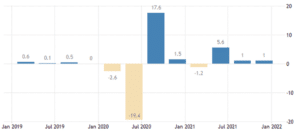
Figure 4: GDP rate of the UK
(Source: Trading Economics, 2022)
In consideration of this, political factors affect the change management programme of Unilever, as the company may not be able to implement changes of expanding to potential nations due to restrictions of export and import instances of the UK. On the other hand, the environmental factor of the UK shows a high rate of GDP that can help companies to strengthen economic conditions within the nation (Trading Economics, 2022). Concerning this, Unilever benefited from proper resources to manage its change within the domain. On the other hand, the inflation rate in the UK is observed to be increasing to 5.5% in 2022, which reflects a negative impact on organisational operations (Trading Economics, 2022). In consideration of this, the National Living Wage of the UK also increased by 2.2%, which further creates a proper scope of maintaining living standards for the population of the UK (BishopFleming, 2022).
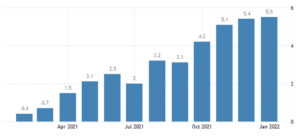
Figure 5: Inflation rate of the UK
(Source: Trading Economics, 2022)
This helps the company to manage its change by providing proper economic conditions and resources while a high inflation rate may not be helpful to provide the company with desired sales rate and profit margin. Other than that, the social factor of the UK reflects a big consumer market with a 68 million population in 2022 (Worldometer, 2022). This factor is seen to be creating a positive impact on Unilever because the program of the company is designed based on the incremental theory of innovation. As a result, this high population can help the company to analyse market trends effectively and implement necessary changes accordingly. Besides, the 99% literacy rate also justified the technical innovation focused by the company (UNA, 2022). Nonetheless, £19.5 billion of technical investments within the domain have been effective for the company to focus on its technical development (Department of International Trade, 2022). This also helps to meet technical needs preferred by customers within the market and thus it creates a positive impact on the organisational operations.
Conclusion and recommendations
Recommendations
In consideration of the current operations of Unilever and the environmental condition, the organisation should follow a certain strategy to executive its change management notion as per consumer trends within the market. As illustrated by Brock et al. (2019), the strategy of change management ensures proper execution of the changing notion while implementing the proper value of the end product. Based on this, the idea put forward by Kotter’s eight steps of change management can be implemented by Unilever to manage its operations. From the figure below, it can be observed that the first step of Kotter’s Change management model indicates creating a sense of agency among stakeholders. As per Caulfield and Brenner (2020), creating urgency among different stakeholders often helps them to understand the necessity of change.
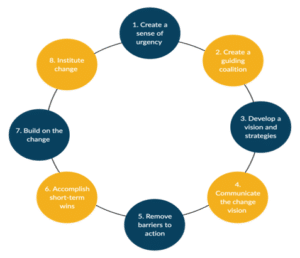
Figure 6: Kotter’s eight steps of change management
(Source: Brock et al. 2019)
The second step of this model indicates creating a guiding coalition and the third step indicates developing proper strategies and a vision for the change. As per the opinion of Kang et al. (2022), guiding the team members is often helpful to execute targeted goals with proper values. The fourth step of this model indicates communication vision while the fifth step indicates removing different barriers for change execution. The last steps of this model indicate the accomplishment of short-term wins, building on the desired change and maintaining the change. Apart from this, Unilever can also implement training and development programs within the organisation to manage change. As per Karim et al. (2019), training and development help in building the skills of employees and develops change management ideas within them. Henceforth, a proper strategic notion will be beneficial for Unilever to manage and execute its organisational changes.
Conclusion
Unilever seems to be highly affected by the changing consumer demand within the market. Due to the prevalence of covid scenario, the demand for hygiene and health products have been increased within the market while lowering the demand for beauty, food and other products served by the company. Concerning this, Unilever created a strategy that increased its production of health and hygiene products and satisfied the needs of customers within the market. On the other hand, drivers of change such as social, technological, environmental, economic, and political factors are also observed to be creating a high impact on the company. The company has been observed to be investing highly in R&D while technology also impacted the change management programme of the organisation. Even, the issues such as political, economical, social, technology and environmental factors as per the PESTLE analysis also impacted the change management strategy of the company and thus the company has been recommended to implement Kotter’s change management model along with training and development to support the changing needs within the organisation.
Reference list
Akinyele, D., Belikov, J. and Levron, Y., 2018. Challenges of microgrids in remote communities: A STEEP model application. Energies, 11(2), p.432.
BishopFleming, 2022. Rise in National Living Wage from April 2021, BishopFleming. [Online], Available at: <https://www.bishopfleming.co.uk/insights/rise-national-living-wage-april-2021#:~:text=The%20National%20Living%20Wage%20(NLW,olds%20for%20the%20first%20time> [Accessed on 20 August 2022]
Brock, J., Peak, K. and Bunch, P., 2019. Intuitively leading change: completing a kinesiology department-to-school transformation using Kotter’s 8-stage change model. J Physl Educ, 6, pp.14-24.
Caulfield, J.L. and Brenner, E.F., 2020. Resolving complex community problems: Applying collective leadership and Kotter’s change model to wicked problems within social system networks. Nonprofit Management and Leadership, 30(3), pp.509-524.
Christodoulou, A. and Cullinane, K., 2019. Identifying the main opportunities and challenges from the implementation of a port energy management system: A SWOT/PESTLE analysis. Sustainability, 11(21), p.6046.
Department of International Trade, 2022. Technology, Department of International Trade. [Online], Available at: <https://www.great.gov.uk/international/content/investment/sectors/technology/?utm_source=google&utm_medium=paidsearch&utm_campaign=ditinvestmentatlashpopaidsearch&utm_content=DSA&gclid=CjwKCAjw_tWRBhAwEiwALxFPoc5a44XFBzz2vpkKTUrgf4OQZVVUMGCP42-xfujYu6kPhJz0rMyb9hoC-ZoQAvD_BwE> [Accessed on 20 August 2022]
Global Newswire, 2022. UK Professional Cleaning Products Market Research Report 2022 Featuring Clorox Company, Paul Hartmann AG, Reckitt Benckiser Group & Unilever, Global Newswire. [Online], Available at: < https://www.globenewswire.com/en/news-release/2022/05/20/2447546/28124/en/UK-Professional-Cleaning-Products-Market-Research-Report-2022-Featuring-Clorox-Company-Paul-Hartmann-AG-Reckitt-Benckiser-Group-Unilever.html> [Accessed on 20 August 2022]
Helo, P. and Hao, Y., 2021. Artificial intelligence in operations management and supply chain management: an exploratory case study. Production Planning & Control, pp.1-18.
Kang, S.P., Chen, Y., Svihla, V., Gallup, A., Ferris, K. and Datye, A.K., 2022. Guiding change in higher education: An emergent, iterative application of Kotter’s change model. Studies in Higher Education, 47(2), pp.270-289.
Karim, M.M., Choudhury, M.M. and Latif, W.B., 2019. The impact of training and development on employees’ performance: An analysis of quantitative data. Noble International Journal of Business and Management Research, 3(2), pp.25-33.
Mckinsey, 2021. The consumer demand recovery and lasting effects of COVID-19, Mckinsey. [Online], Available at: < https://www.mckinsey.com/industries/consumer-packaged-goods/our-insights/the-consumer-demand-recovery-and-lasting-effects-of-covid-19> [Accessed on 20 August 2022]
OECD, 2022. The Changing Consumer and Market Landscape, OECD. [Online], Available at: <https://www.oecd.org/berlin/45710126.pdf> [Accessed on 20 August 2022]
Overseas, 2021. Overview of Korea-UK Relations, Overseas. [Online], Available at: < https://overseas.mofa.go.kr/gb-en/brd/m_8348/view.do?seq=618999&srchFr=&srchTo=&srchWord=&srchTp=&multi_itm_seq=0&itm_seq_1=0&itm_seq_2=0&company_cd=&company_nm=#:~:text=The%20two%20countries%20have%20become,consultation%20between%20the%20two%20governments > [Accessed on 20 August 2022]
Parrish, B., Heptonstall, P., Gross, R. and Sovacool, B.K., 2020. A systematic review of motivations, enablers and barriers for consumer engagement with residential demand response. Energy Policy, 138, p.111221.
Rubin, G.D. and Abramson, R.G., 2018. Creating value through incremental innovation: Managing culture, structure, and process. Radiology, 288(2), pp.330-340.
Sabanoglu, T., 2022. Unilever: revenue worldwide 2007-2021, Statista. [Online], Available at: <https://www.statista.com/statistics/269190/global-revenue-of-the-unilever-group-since-2007/> [Accessed on 20 August 2022]
Smith, J., 2022. Unilever Uses Virtual Factories to Tune Up Its Supply Chain, The Wall Street Journal. [Online], Available at: <https://partners.wsj.com/samsung/technology-speed-of-change/unilever-uses-virtual-factories-to-tune-up-its-supply-chain/#:~:text=Consumer%2Dgoods%20giant%20Unilever%20PLC,enable%20testing%20of%20operational%20changes.> [Accessed on 20 August 2022]
Statista, 2022. Respondents who bought more cleaning products than usual in the UK 2020-2021, Statista. [Online], Available at: <https://www.statista.com/statistics/1195898/cleaning-product-buying-trends-due-to-covid19-uk/> [Accessed on 20 August 2022]
Trading Economics, 2022. United Kingdom GDP Growth Rate, Trading Economics. [Online], Available at: <https://tradingeconomics.com/united-kingdom/gdp-growth> [Accessed on 20 August 2022]
Trading Economics, 2022. United Kingdom Inflation Rate, Trading Economics. [Online], Available at: <https://tradingeconomics.com/united-kingdom/inflation-cpi> [Accessed on 20 August 2022]
UNA, 2022. INTERNATIONAL LITERACY DAY, UNA. [Online], Available at: <https://una.org.uk/international-literacy-day-factsheet#:~:text=In%20the%20UK%20the%20literacy,struggle%20to%20read%20and%20write> [Accessed on 20 August 2022]
Unilever, 2020. The sustainable tech that’s changing lives, Unilever. [Online], Available at: <https://www.unilever.com/news/news-search/2018/the-sustainable-tech-thats-changing-lives/> [Accessed on 20 August 2022]
Unilever, 2020. Unilever develops new technology to tackle the global issue of plastic sachet waste, Unilever. [Online], Available at: <https://www.unilever.com/news/press-and-media/press-releases/2017/unilever-develops-new-technology-to-tackle-the-global-issue-of-plastic-sachet-waste/> [Accessed on 20 August 2022]
Unilever, 2022. Delivering consistency in challenging conditions, Unilever. [Online], Available at: <https://www.unilever.com/news/press-and-media/press-releases/2022/delivering-consistency-in-challenging-conditions/> [Accessed on 20 August 2022]
Unilever, 2022. Home, Unilever. [Online], Available at: <https://www.unilever.com/> [Accessed on 20 August 2022]
Unilever, 2022. Innovating boldly for people and the planet, Unilever. [Online], Available at: < https://www.unilever.com/brands/innovation/> [Accessed on 20 August 2022]
Unilever, 2022. Innovation in Unilever, Unilever. [Online], Available at: <https://www.hul.co.in/our-company/rd-innovation/innovation-in-unilever/> [Accessed on 20 August 2022]
Unilever, 2022. Unilever at a glance, Unilever. [Online], Available at: < https://www.unilever.com/our-company/at-a-glance/> [Accessed on 20 August 2022]
Unilever, 2022. Unilever Full Year Results 2021, Unilever. [Online], Available at: < https://www.unilever.com/news/press-and-media/press-releases/2022/unilever-full-year-results-2021/> [Accessed on 20 August 2022]
Worldometer, 2022. U.K. Population, Worldometer. [Online], Available at: <https://www.worldometers.info/world-population/uk-population/> [Accessed on 20 August 2022]
Appendices
Appendix 1: Hygiene products demand in the UK
(Source: Statista, 2022)
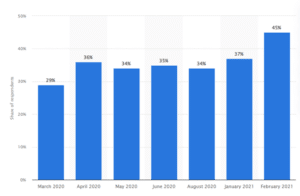
Appendix 2: Incremental innovation
(Source: Rubin and Abramson, 2018)

Appendix 3: PESTLE analysis
| Factors | Impact |
| Political |
|
| Economical |
|
| Social |
|
| Technological |
|
| Environmental
|
|
| Legal |
|

